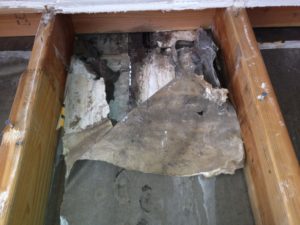
Problematic Mold
A little water can do a lot of damage to your new custom home. Moisture trapped behind the façade (siding, shingles or panels) can cause mold and rot which can literally kill you. Fixing moisture problems has become a billion-dollar industry.
Over time, the building components of a house can break down. Houses settle, thermal expansion and contraction occurs causing cracks to appear in the exterior trim, siding and caulking. Errors made during construction, such as gaps in the framing and not sealing the building envelope, are pathways for water intrusion. Not installing weather resistant materials and deferred maintenance are other culprits.
The air pressure inside the home is less than the air pressure outside of the home. So, it’s easy to see how wind-driven rain can penetrate the building envelope. A few minutes of wind-driven rain can push the water through the smallest of cracks or spaces in a home’s exterior. In order to avoid this a house would have to be perfectly sealed.
Innovative Solutions for New Home Construction
So how do we mitigate this condition? Just add a rainscreen system in your new home. Rainscreens create a space between the sheathing and the outer wall. This air space helps to equalize the pressure between the exterior and the interior of the house.
Water passing through the facade enters this space created by the rainscreen and drains out at the bottom of the wall allowing the wall to dry. For a rain screen to be effective the inner wall should be airtight. Rainscreen walls typically have a 3/8” to 3/4” gap between the siding and the sheathing.
There are ready-made strip products on the market for purchase or you can make your own by ripping 1-1/2” wide strips from a sheet of 3/8” – 3/4” treated plywood. Attach these strips to the stud locations on the wall sheathing, add a bug screen at the bottom and a vent at the top.
If venting is done at the top of the wall in order to facilitate drainage, the top of the wall should be sealed so that water cannot enter at the roofline. The façade is then attached to the strips creating the air gap.
The siding can eliminate the need for venting at the top if the overlap in the siding is not airtight, allowing air to enter, equalizing the pressure and allowing the water to drain out of the bottom of the cavity. Proper flashing is also important so that the water drains outside the trim and the siding.
Added Benefits for Denver Custom Home Builders
The ventilation a rain screen provides also reduces solar heat gain in the summer, reducing the home cooling load, cutting down on environmental emissions and saving you money. Another benefit is sound attenuation providing a quieter indoor environment.
Rainscreens are cost-effective inexpensive insurance that keeps your home dry, protects your family against mold and secures your investment.
Call with any questions: 303-756-8870